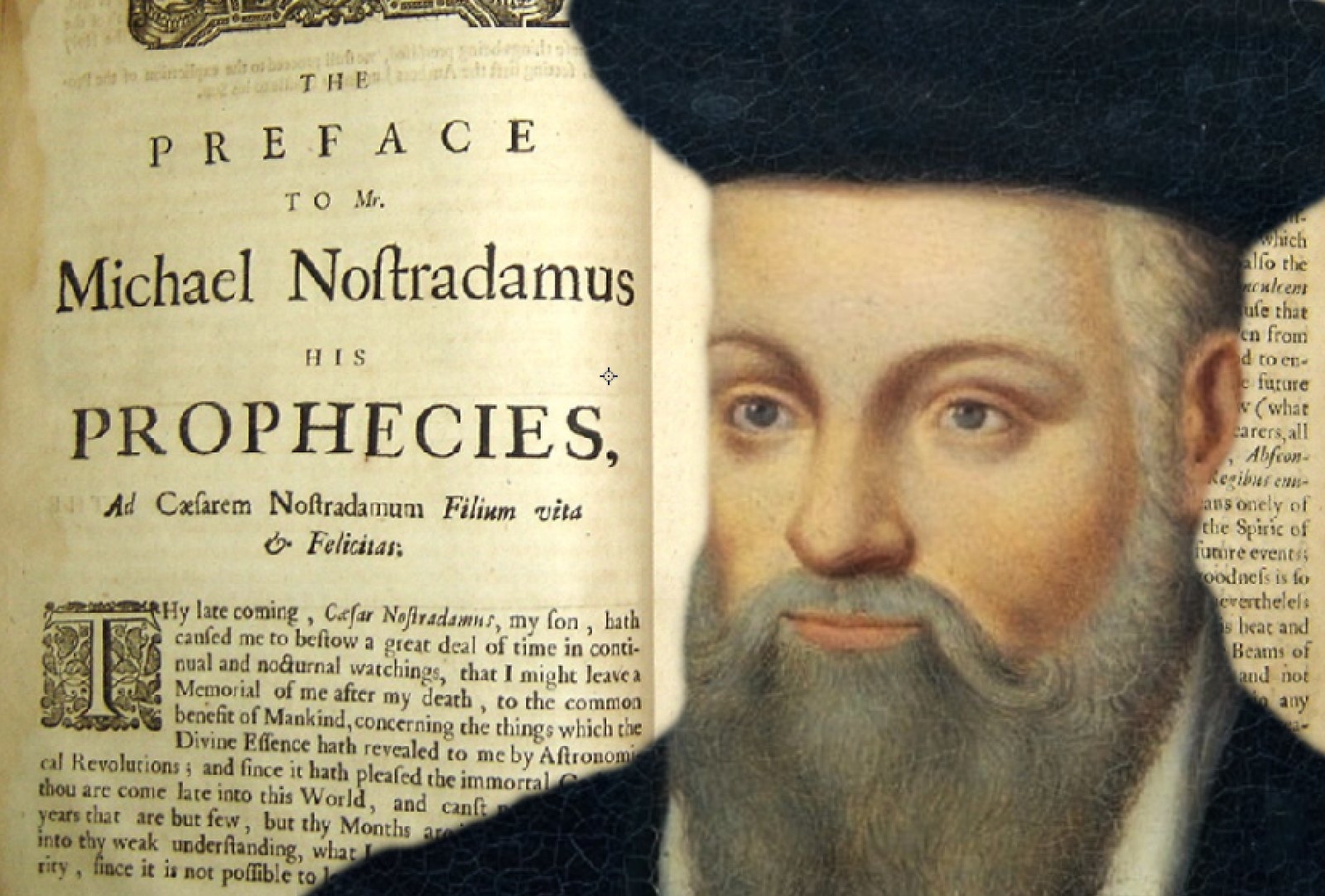The eternal and controversial Nostradamus
In the 16th century European society was confused, violent, chaotic, filthy and desperate for answers and solutions to the problems of the moment. Due to the Reformation, mysticism burst in all its palettes, celebrities and idiots alike pretending that they were able to unravel God’s plans by exploring different aspects of reality. In addition to the Parisian elites who created Tabulae Alphonsinae or personalities such as d’Ailly, De Bruges and Turrel, the French territories were sprinkled with a multitude of petty astrologers who combined the reading of the stars with visions, magic, alchemy and mathematics. But, surprisingly, of the multitude of mystics, the best-known today is not a personality of the time, but a certain Michel de Nostredame, better known after his Latinized name “Nostradamus.”
Even though he is often brought into question and he is the subject of hundreds of studies, little is known about the life of Nostradamus. Of Jewish origins, Nostradamus was born in 1503 in Southern France, being one of the approximately nine children of Renée de Saint-Rémy and the notary Jaume de Nostredame. Following the trend of the time, Nostradamus was a polymath: he learned several languages, studied history, mathematics, human nature, sought to predict the future and to understand the Bible, traveled frequently and managed to obtain a doctorate in medicine, although he unsuccessfully tried to cure plague.505 In 1547 he married the wealthy widow Anne Ponsard, who gave him six children. The new financial status introduced Nostradamus in high circles and allowed him to give up medicine and turn to the study of mysticism. He modestly began his life of astrologer, publishing an almanac for the year 1550 in natural astrology, on the cover appearing for the first time his Latinized name. The subject of the almanac was the meteorological anticipation on astrological bases. Encouraged by the confirmation of a small number of predictions, he began to publish almanacs in series, two or three every year, with previsions of varied complexity. These were composed of one quatrain for every year, a quatrain for every month and one for every day, all containing meteorological previsions and medical and agricultural advice. In total, from 1550 until his death in 1566, Nostradamus wrote 11 almanacs, which brought him some popularity. In a great measure due to these petty publications the local nobility and other prominent figures ordered from him horoscopes and “parapsychological” counseling, although his clients supplied their birth dates, and he did not calculate them himself as a professional astrologer.506
After he got bored with almanacs and horoscopes, he began to work on his book of over 1,000 quatrains – the undated prophecies that made him famous. It was a transition from natural astrology (considered simpler) toward judicial astrology (more complex), a natural step for any astrologer who aimed to evolve. At this point the admirers of Nostradamus believe that the prophet wished to avoid the religious censorship and, accordingly, he hid the true meaning of his message by using a “Virgilianised” syntax (after the Roman poet Publius Vergilius Maro); the Nostradamic quatrains contain word games, a mixture of other languages, symbols, metaphors and names within which letters are changed or added. Nostradamus mixed the meaning and the order of the quatrains, so that mankind could not use them until it would discover sophisticated methods of decoding. Moreover, his defenders argue that he was obliged to write them cryptically, because the alchemical tradition imposed the mandatory encryption of the esoteric knowledge, on the grounds that in this way only those who were supposed to would understand it.
On the other hand, the skeptics argue that the vague style was deliberately adopted in order to let the writings open to interpretations and to hide the real ineptitude that sat behind them. Neither prophecy nor astrology attracted severe punishments from the ecclesiastical or secular authorities, but only magic. His short incarceration at Marignane at the end of 1561 was due to the fact that he had published an almanac without the prior permission of a bishop according to the royal decree. But the relation of Nostradamus with the church was almost always good, as it was also his relation with the ruling class for which he made horoscopes.507
Donald Trump is poised to win the Republican presidential nomination, and might actually become president. That's something most experts said would never, ever happen.

But there was one guy who did correctly predict the rise of Trump: famous French psychic Nostradamus, who lived 500 years ago. At least, that's according to some people on the internet.

The most popular theory online? Trump is the "third Antichrist" predicted by Nostradamus, after Napoleon and Hitler. This is kind of a big deal, because the third Antichrist will trigger the end of the world.

All the quatrains were compiled and published in the work entitled Les prophéties, his major collection of long-term prophecies. The first edition of Les prophéties was published in 1555. The second, which contained 289 more verses, was printed in 1557. The third edition, with 300 new quatrains, was printed in 1558, but it is assumed that a part of them have been lost. This last version contains a single unrhymed quatrain and 941 rhymed, grouped in nine sets of 100 and a set of 42 – sets named “centuries.” But, due to the printing practices of the 16th century (which also included printing after dictation), none of the editions are identical.508 Hence, there is no guarantee that the writing and punctuation of the later editions totally belong to Nostradamus – an insurmountable impediment for those who have tried to find hidden codes in his texts.
Although today Nostradamus is generally depicted as an eminent prophet of his time, his contemporaries had an entirely different opinion. When the first edition of Les prophéties was published, the author was categorized by the readers as a devil’s servant, liar, madman, or as a gifted man.509 Nostradamus claimed that he had written his work respecting the principles of judicial astrology, but he was criticized by contemporary professional astrologers for incompetence.510
Les prophéties is the only work that has enjoyed popularity after the death of the author; the rest of the publications have been simply ignored. Until the end of the 20th century around 200 editions of the work came to the surface, together with a couple of thousand commentaries. It is debatable if in the preface to his main work – written under the form of a letter addressed to his son César – he pretends or not that he had divine revelations, but it is certain that he does not fit the traditional image of the biblical prophet. On the contrary, although within the same text he assigns the merit of his work to the all-powerful God, Nostradamus seems to have used divination to formulate his prophecies.
Nostradamus was very versed in the art of divination, befitting the classic image of the medieval astrologer or magician who works to achieve and to perfect the prophetic talent. It is believed that the prophecies were written in a state of trance similar to self-imposed hypnosis. In order to enter this state, he used objects considered to have magical properties, such as the pendulum, and he concentrated on fire or water. He transformed his attic into a small workshop, where during trances he sat at the table, in front of a mirror, with his hand on the knees, in a cool atmosphere, lit only by a few candles. In front of him a bowl with various oils and hot water was placed. It is speculated that before meditations he consumed nutmeg, a mild hallucinogenic plant that stimulates imagination, but it is lethal in large quantities. Sometimes, sitting on the tripod, he watched the night sky while the secrets of the future were dictated to him by an entity called the “inner light,” the “voice” or the “angelic spirit.” According to legend, Nostradamus once summoned the angel Anael and asked him to show him in a magical mirror the fate of the queen’s children.511
The prophet’s supporters say that these aspects are mere legends or fabrications meant to discredit him. It cannot be determined with certainty if Nostradamus did or did not use methods to enter certain mental states. The only and few descriptions of this process are depicted in his Latin correspondence, especially in the letter to François Bérard. In his letter to King Henry II of France Nostradamus speaks about emptying the soul, the mind and the heart of all cares through calm and tranquility.512Nevertheless, in the context of the 16th century, the usage of divination would not be an abnormality, but rather a natural thing. And, if Nostradamus used indeed rituals to see the future, then his prophecies are worthless, because no one can become a prophet through his own will and by forcing God to reveal him his plans.
Even if Nostradamus was special and he did not use rituals to discover the future, there are strong indications that his writings are plagiarisms, and the so-called prophecies are in fact postdictions. Much of his prophetic work paraphrases ancient apocalyptic and historical texts, all projected in the future with the help of comparative horoscopy. This explains the mentioning in the quatrains of historical personalities such as ... (This text is incomplete. If you wish to read it in full, please purchase the book)
... are usually the result of faulty interpretations or translations (sometimes intentional), for otherwise they were written with such a deep and deliberate imprecision that they have a null prophetic value. Despite what is shouted in the mass media, the ratio between quality and quantity speaks for itself: in less than three years Nostradamus wrote almost every day, reaching over 4,500 verses. The supporters of Nostradamus dare to say that the precision is mathematical, but the reality is very different. The “amazing prophecies” of Nostradamus made with “mathematical precision” are not amazing at all and they do not have the slightest precision. They are totally chaotic and this thing is reflected in absolutely all the failed forecasts based on his quatrains. But, ironically, the prophecies are popular exactly due to their vagueness. The quatrains deliberately contain vague and general terms in order to stimulate selective thinking: there are no rules of interpretation, the texts can be suited to any major event, the prophetic failures are omitted or ignored, and the seeming successes are overrated. The message of Nostradamus in the letter to his son César, in which he states that the quatrains were written in a nebulous form rather than clear prophetic, can easily be seen as a “blank check”: they can mean almost anything they are supposed to mean.554 A proof in this regard is also the fact that the Nostradamic exegesis is full of linguistic evasions such as “it is possible,” “probably that,” “might be,” “might mean,” thereby minimizing the failure and leaving the possibility for the texts to be recycled for other real correspondences.
The prophetic reputation of Nostradamus is a product of the chameleonic exegetes eager to gain, while the pieces of evidence lead to the idea that the prophecies were constructed through the method of postdiction (retroactive clairvoyance) as well. Postdiction is a prophecy so ambiguous that it can be easily associated with subsequent random events, or it is a precise statement about an event which the prophet falsely claims that he knew before it happened.555 In the case of Nostradamus the following aspects are easily noticeable: the ambiguous statements, the open ending, the wide range of events he covers, the impossibility to identify the events until their consummation, the recycling of the prophecies and their usage for multiple events,556 and last but not least the mania of the exegetes to launch allegorical superficial explanations to transform failures into successes.
In conclusion, due to the lack of detailed information, Nostradamus might have been exceptional compared to 16th-century mass of seers. Likewise, the divinatory practices might be mere legends. But the quality of his prophecies cannot be contested. The ration between the total volume of the Nostradamic prophecies557 and the volume of prophecies said to come true is weaker than pure chance. Although in the preface of his main work Nostradamus states that the secret of deciphering the prophecies is closed in his heart, the reality of 500 years of failed exegesis indicates the fact that we stand in front of an out-of-control prophetic joke. Nostradamus gained worldwide notoriety through an accident of history, but in the end he was, like his contemporaries, only a product of the times he lived in. Just the fact that the original French prophecies are organized in rhymed quatrains proves that they were not meant to communicate a certain message, but to entertain the bored society of his period. Unfortunately, Nostradamus will continue to remain for a long time the main character of the prophetic universe due to the financial benefits it generates. As long as Nostradamus the prophet enjoys an exceptional image, constantly “cleaned” of the naiveties of the 16th century, mystics, mediums and exegetes are able to sell their scribble. And while prophetic personalities such as d’Ailly, De Bruges or Gaurico have been forgotten when the occult collapsed, the ambiguity of the Nostradamic prophecies was, is and will be an inexhaustible source of stimulating the imagination and profit.

No comments:
Post a Comment